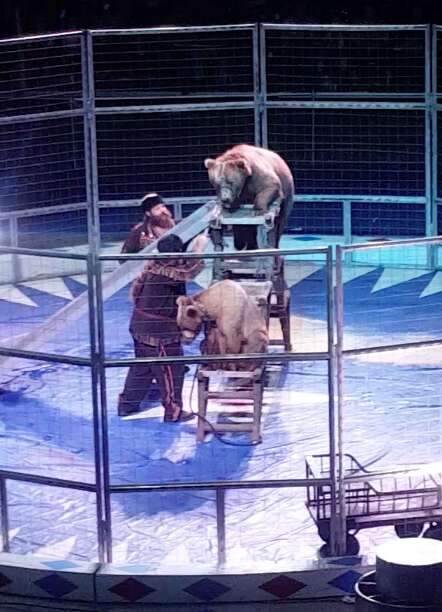Video Shows Circus Bears Wracked With Terror During Performance
The bears display some very strange behaviors.
“Please welcome Rosaire’s Bears,” an announcer croons into a microphone as two brown bears appear onstage, restrained by muzzles and leashes.
The bears’ handlers yank their leashes, making the bears walk on their hind legs like humans while drinking from bottles, and leap up onto barrels and chairs.
But one of the bears, believed to be named Chopper, doesn’t listen to his trainer’s commands. Instead, he urinates, which can be a sign of extreme fear. Later, he does it again.
The bears are owned by Rosaire’s Bears, a company that trains wild animals for entertainment and moves them around the country to perform at different locations. This performance, which was captured in a video, took place in April at the Shrine Circus in Bangor, Maine.
“This is run-of-the-mill for circus acts,” Debbie Metzler, a captive wildlife specialist for the PETA Foundation, told The Dodo. “The two bears, believed to be Indian and Chopper, were almost constantly slapped, poked and jabbed. They were pulled hard by leads, and coerced to walk and sit like humans, push carts and climb ladders, which are all things that can lead to muscle and joint pain, injury and even chronic psychological distress.”

But it’s the urinating incident that Metzler is most concerned about — she believes it’s a sign of psychological, and maybe even physical, stress. The bear also can be seen drinking his urine, which isn’t normal behavior.
“A bear expert reviewed that video, and said that the urination was likely a severe distress response to being forced to perform uncomfortable acts,” Metzler said. “And drinking urine is also an abnormal behavior, and it could be caused by some underlying physiological concern like nutritional deficiency or dehydration. It could also be a coping mechanism, as a result of psychological suffering.”

To get bears to perform in circuses, trainers often use intimidation and physical violence.
“They [the animals] are fearful of the whips, sticks and other weapons that are used to force them to perform,” Metzler said. “They do [the tricks] ... onstage in front of a crowd because they have learned to fear these tools, and they don’t know when the next abuse is going to happen.”
DJ Schubert, a wildlife biologist with the Animal Welfare Institute (AWI), suspects that the trainers may have even burned the bears’ front paws to get them to walk on their hind legs.

"Bears are quadrupeds,” Schubert told The Dodo. “They would never naturally walk in an upright position on two feet nor would they walk backwards in the wild. To train a bear to perform such an unnatural act requires the use of cruel methods. While it is unknown how this particular trainer forced the bears to walk upright, a method that has been used by other trainers is to burn the bear's front paws.”
“Also, there’s a lot of mental deprivation that they experience when they’re torn from their mothers when they’re babies,” Metzler added. “They’re locked in cages and they’re moved from city to city, typically in trailers that are cramped and filthy, so they’re just denied all resemblance of a normal life, and they experience a lot of psychological stress because of that.”

Unfortunately, scenes like this are all too common — and happen around the world.
A recent video of a circus performance in Volgograd Oblast, Russia, shows a scared performing bear trying to run offstage — but trainers beat him into submission. In response, the bear attacks one of the trainers, tackling him to the ground. While the trainer ends up being OK, the bear appears to be psychologically traumatized, rocking back and forth in front of the trainers after the incident.

But it’s not just bears who are forced to perform — elephants, tigers, lions, dolphins, monkeys and other animals are also commonly used for entertainment purposes and face similar abuses.
“Bears don't belong in circuses and should not be forced to perform unnatural acts for gawking humans,” Schubert said. “They belong in the wild or, in the case of this particular bear and the younger bear that was also in the performance, in an accredited animal sanctuary to live out their natural lives as bears."